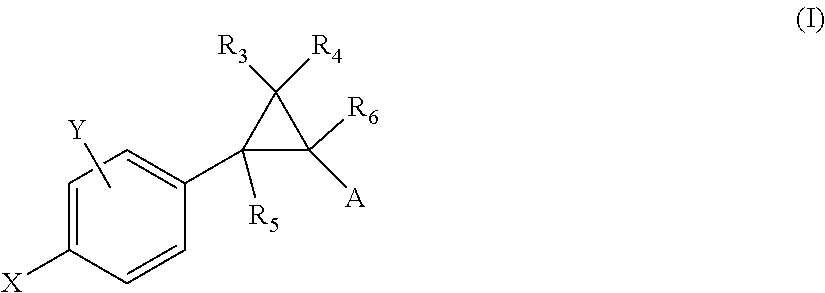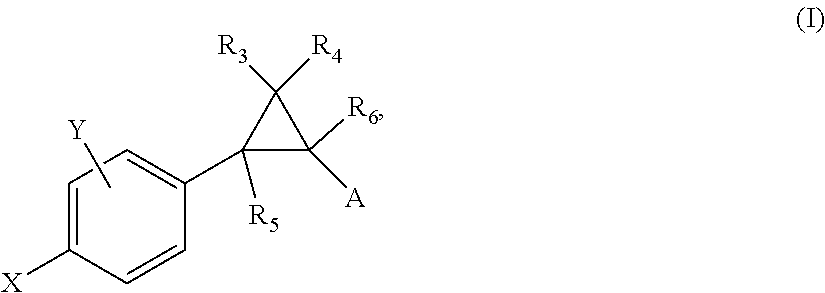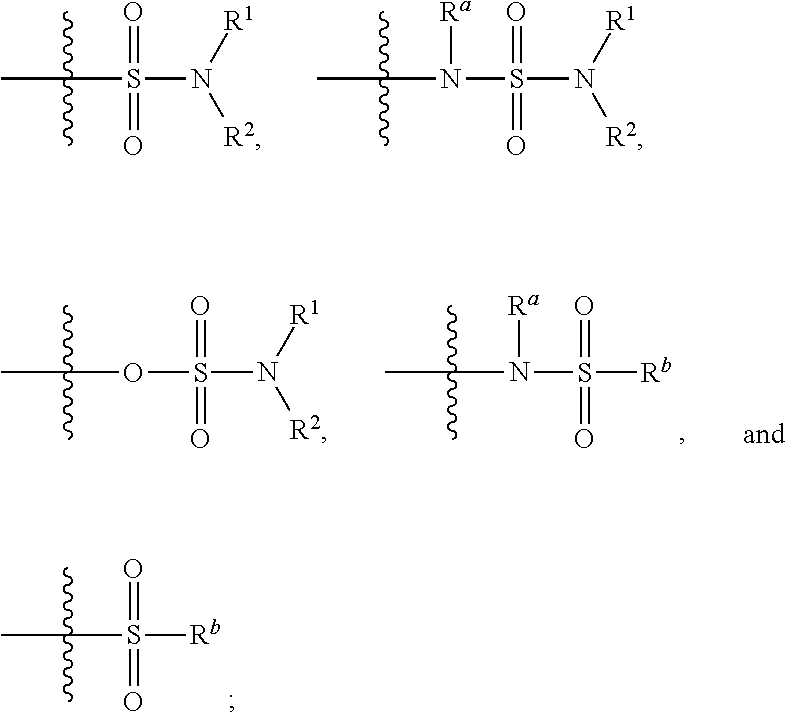Substituted 6-membered aryl or heteroaryl allosteric modulators of nicotinic acetylcholine receptors
a technology of nicotinic acetylcholine receptors and allosteric modulators, which is applied in the direction of heterocyclic compound active ingredients, drug compositions, organic chemistry, etc., can solve problems such as dyskinesia, and achieve the effect of preventing, treating or reducing diseas
- Summary
- Abstract
- Description
- Claims
- Application Information
AI Technical Summary
Benefits of technology
Problems solved by technology
Method used
Image
Examples
example 1
[0275]
4-{trans-2-[6-(Propan-2-yl)pyridin-2-yl]cyclopropyl}benzenesulfonamide, Enantiomer B
Step A: 2-(trans-2-Phenylcyclopropyl)-6-(propan-2-yl)pyridine
[0276]To a solution of (trans-2-phenylcyclopropyl)boronic acid (Intermediate 1) (211 mg, 1.30 mmol) in toluene (3.3 mL) were added 2-bromo-6-isopropylpyridine (137 mg, 0.685 mmol) and tribasic potassium phosphate (436 mg, 2.05 mmol) and the reaction mixture deoxygenated with nitrogen. Palladium(II) acetate (30.7 mg, 0.137 mmol), di(1-adamantyl)-n-butylphosphine (98 mg, 0.27 mmol), and water (0.2 mL) were added and the reaction mixture deoxygenated with nitrogen, sealed, warmed to 100° C., and allowed to stir for 4 h. The reaction mixture was concentrated under reduced pressure and the residue purified by silica gel chromatography, eluting with a gradient of ethyl acetate:hexanes-0:100 to 50:50 to afford the title compound. MS: m / z=238.2 [M+H].
Step B: 4-{trans-2-[6-(Propan-2-yl)pyridin-2-yl]cyclopropyl}benzenesulfonamide, Enantiomer B
[...
example 2
[0278]
4-{trans-2-[2-(Morpholin-4-yl)pyrimidin-4-yl]cyclopropyl}benzenesulfonamide
[0279]To a solution of N-[(dimethylamino)methylidene]-4-{trans-2-[3-(dimethylamino)prop-2-enoyl]cyclopropyl}benzenesulfonamide (Intermediate 12) (30 mg, 0.086 mmol) in ethanol (1.1 mL) were added potassium carbonate (23.7 mg, 0.172 mmol) and morpholine-4-carboximidamide (16.7 mg, 0.129 mmol). The reaction mixture was warmed to 80° C. and allowed to stir for 14 h. The reaction mixture was cooled to ambient temperature, concentrated under a stream of nitrogen, and the resulting residue purified by preparative HPLC, eluting with a gradient of acetonitrile:water:trifluoroacetic acid-10:90:0.1 to 40:60:0.1 to afford the title compound. MS: m / z=360.1 [M+H]. 1H NMR (500 MHz, DMSO-d6): δ 8.20 (d, J=5.0 Hz, 1H); 7.72 (d, J=8.1 Hz, 2H); 7.37 (d, J=8.2 Hz, 2H); 7.28 (s, 2H); 6.69 (d, J=5.0 Hz, 1H); 3.66-3.68 (br m, 8H); 2.33 (br s, 2H); 1.77 (br s, 1H); 1.58 (br s, 1H).
example 3
[0280]
4-[trans-2-(6-Cyclopentylpyridin-2-yl)cyclopropyl]benzenesulfonamide, Enantiomer B
Step A: 2-Cyclopentyl-6-(trans-2-phenylcyclopropyl)pyridine
[0281]To a solution of (trans-2-phenylcyclopropyl)boronic acid (Intermediate 1) (681 mg, 4.20 mmol) in a mixture of toluene (10.5 mL) and water (0.6 mL) were added 2-bromo-6-cyclopentylpyridine (500 mg, 2.21 mmol) and tribasic potassium phosphate (1.41 g, 6.63 mmol) and the reaction mixture deoxygenated with nitrogen. Palladium(II) acetate (99 mg, 0.44 mmol) and di(1-adamantyl)-n-butylphosphine (317 mg, 0.885 mmol) were added and the reaction mixture warmed to 110° C. and allowed to stir for 4 h. The reaction mixture was diluted with ethyl acetate (20 mL), washed with water (10 mL) and saturated aqueous sodium chloride (10 mL), dried (magnesium sulfate), and concentrated under reduced pressure. The residue was purified by silica gel chromatography, eluting with a gradient of ethyl acetate:hexanes-5:95 to 100:0 to afford the title compound...
PUM
| Property | Measurement | Unit |
|---|---|---|
| temperature | aaaaa | aaaaa |
| temperature | aaaaa | aaaaa |
| temperature | aaaaa | aaaaa |
Abstract
Description
Claims
Application Information
 Login to View More
Login to View More - R&D
- Intellectual Property
- Life Sciences
- Materials
- Tech Scout
- Unparalleled Data Quality
- Higher Quality Content
- 60% Fewer Hallucinations
Browse by: Latest US Patents, China's latest patents, Technical Efficacy Thesaurus, Application Domain, Technology Topic, Popular Technical Reports.
© 2025 PatSnap. All rights reserved.Legal|Privacy policy|Modern Slavery Act Transparency Statement|Sitemap|About US| Contact US: help@patsnap.com



